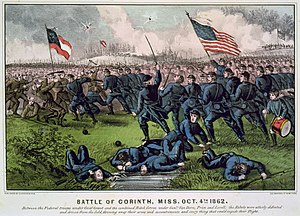Battle of Corinth II
| Second Battle of Corinth | |||||||
|---|---|---|---|---|---|---|---|
| Part of the American Civil War | |||||||
 Battle of Corinth, Miss., October 4, 1862. Hand-colored lithograph by Currier and Ives, 1862 |
|||||||
|
|||||||
| Belligerents | |||||||
|
|
|
||||||
| Commanders and leaders | |||||||
| William Rosecrans |
Earl Van Dorn Sterling Price |
||||||
| Units involved | |||||||
| Army of the Mississippi | Army of West Tennessee | ||||||
| Strength | |||||||
| c. 23,000 | c. 22,000 | ||||||
| Casualties and losses | |||||||
|
2,520 (355 killed; 1,841 wounded; 324 captured/missing) |
4,233 (473 killed; 1,997 wounded; 1,763 captured/missing) |
||||||
The Second Battle of Corinth (which, in the context of the American Civil War, is usually referred to as the Battle of Corinth, to differentiate it from the Siege of Corinth earlier the same year) was fought October 3–4, 1862, in Corinth, Mississippi. For the second time in the Iuka-Corinth Campaign, Union Maj. Gen. William Rosecrans defeated a Confederate army, this time one under Maj. Gen. Earl Van Dorn.
After the Battle of Iuka, Maj. Gen. Sterling Price marched his army to meet with Van Dorn's. The combined force, under the command of the more senior Van Dorn, moved in the direction of Corinth, a critical rail junction in northern Mississippi, hoping to disrupt Union lines of communications and then sweep into Middle Tennessee. The fighting began on October 3 as the Confederates pushed the U.S. Army from the rifle pits originally constructed by the Confederates for the Siege of Corinth. The Confederates exploited a gap in the Union line and continued to press the Union troops until they fell back to an inner line of fortifications.
On the second day of battle, the Confederates moved forward to meet heavy Union artillery fire, storming Battery Powell and Battery Robinett, where desperate hand-to-hand fighting occurred. A brief incursion into the town of Corinth was repulsed. After a U.S. counterattack recaptured Battery Powell, Van Dorn ordered a general retreat. Rosecrans did not pursue immediately and the Confederates escaped destruction.
As Confederate General Braxton Bragg moved north from Tennessee into Kentucky in September 1862, Union Maj. Gen. Don Carlos Buell pursued him from Nashville with his Army of the Ohio. Confederate forces under Van Dorn and Price in northern Mississippi were expected to advance into Middle Tennessee to support Bragg's effort, but the Confederates also needed to prevent Buell from being reinforced by Maj. Gen. Ulysses S. Grant's Army of the Tennessee. Since the conclusion of the Siege of Corinth that summer, Grant's army had been engaged in protecting supply lines in western Tennessee and northern Mississippi. At the Battle of Iuka on September 19, Maj. Gen. Sterling Price's Confederate Army of the West was defeated by forces under Grant's overall command, but tactically under Rosecrans, the commander of the Army of the Mississippi. (Grant's second column approaching Iuka, commanded by Maj. Gen. Edward Ord, did not participate in the battle as planned. An acoustic shadow apparently prevented Grant and Ord from hearing the sounds of the battle starting.) Price had hoped to combine his small army with Maj. Gen. Earl Van Dorn's Army of West Tennessee and disrupt Grant's communications, but Rosecrans struck first, causing Price to retreat from Iuka. Rosecrans's pursuit of Price was ineffectual.
...
Wikipedia
